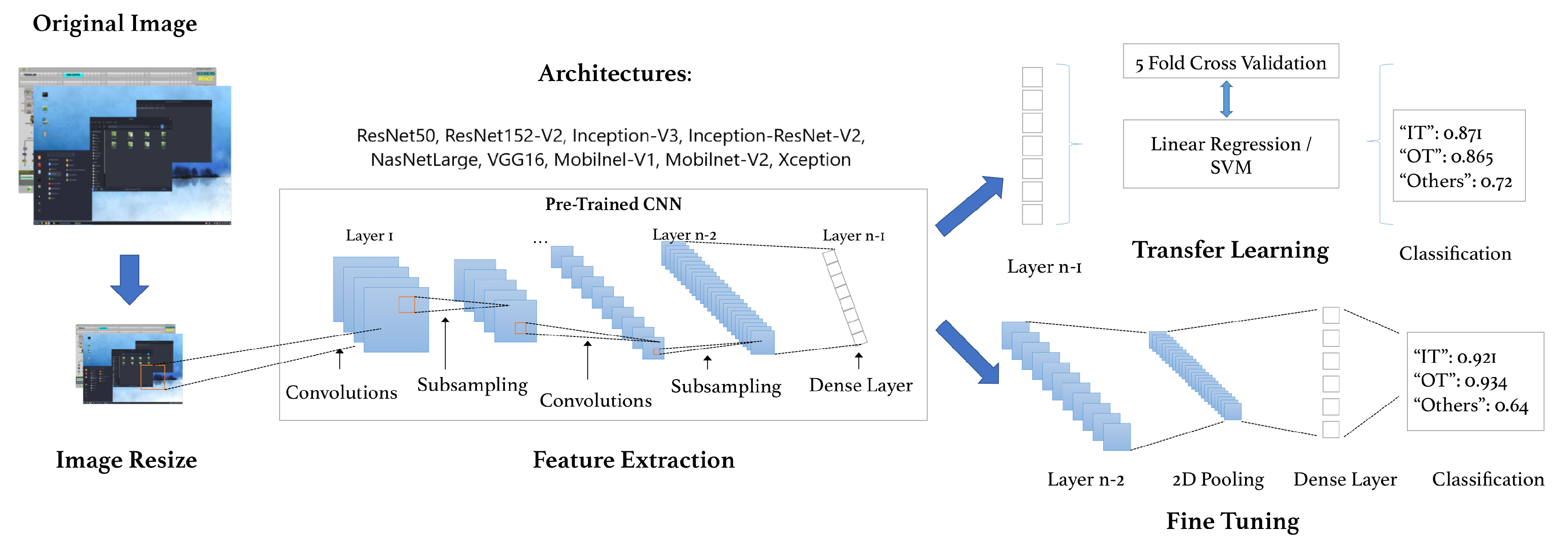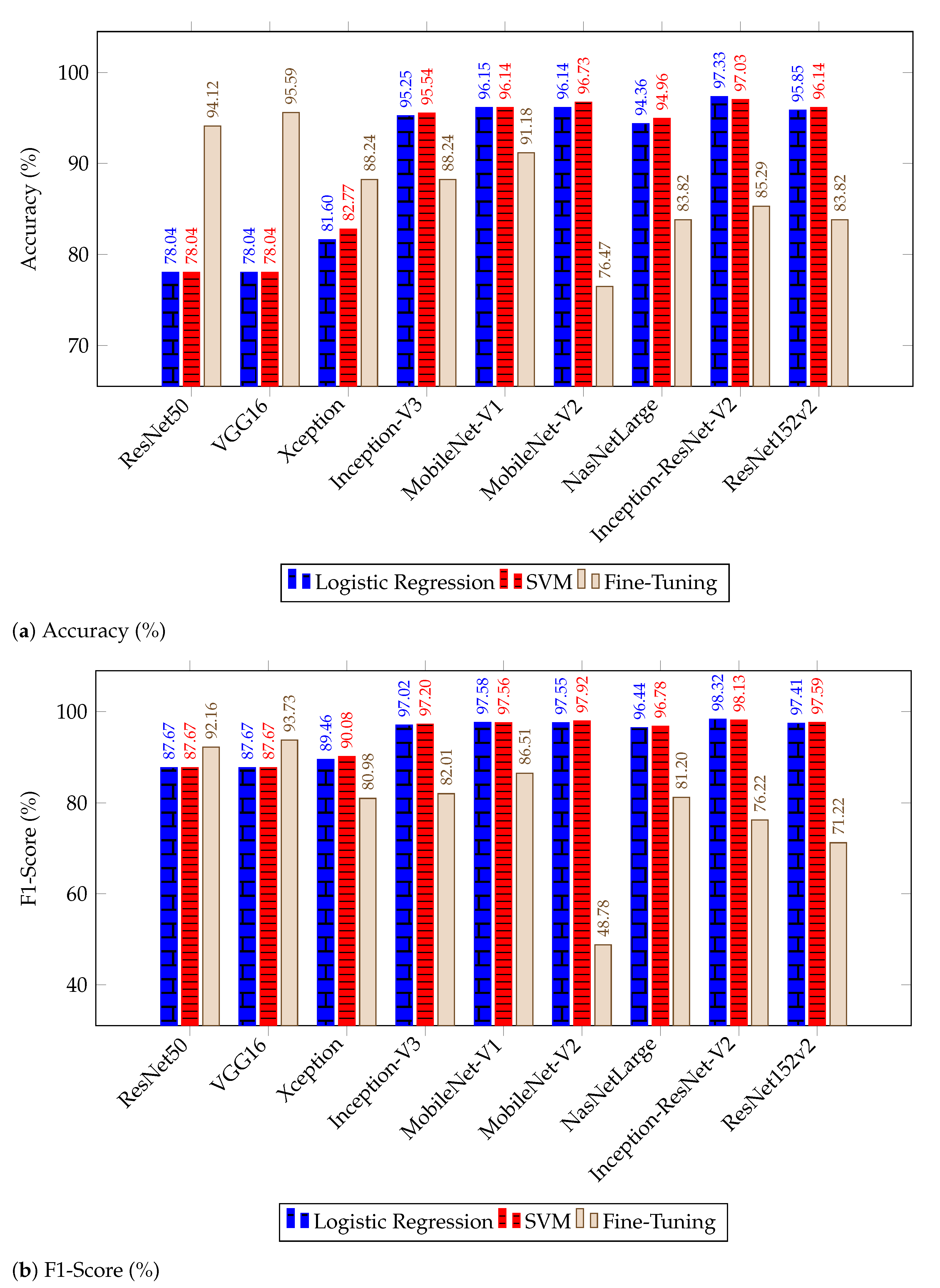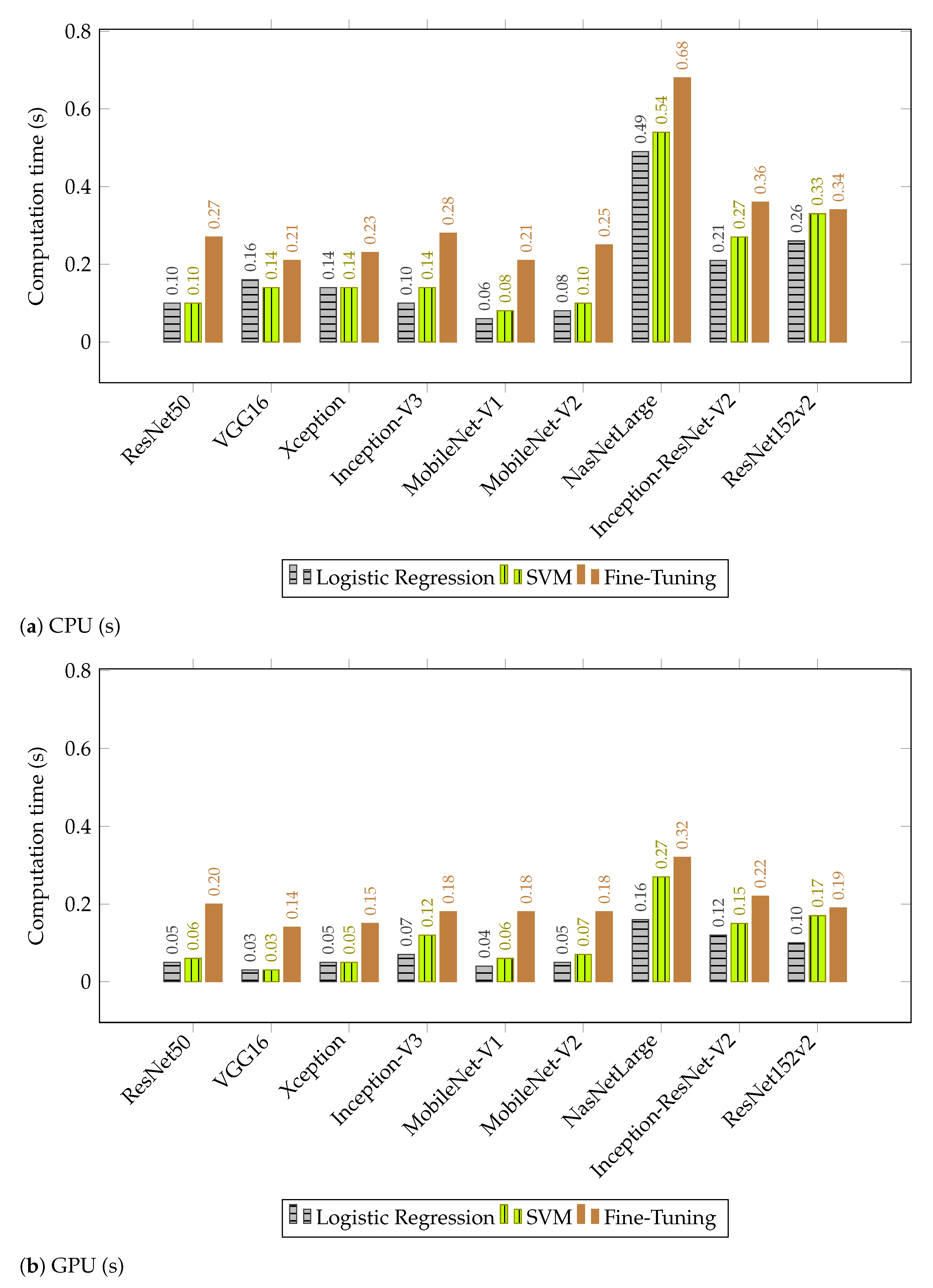Detecting Vulnerabilities in Critical Infrastructures by Classifying Exposed Industrial Control Systems Using Deep Learning
Abstract
Featured Application
Abstract
1. Introduction
2. State of the Art
3. Methodology
3.1. Critical Infrastructure Dataset
3.2. Proposed Pipeline
3.2.1. Transfer Learning and Fine-Tuning
3.2.2. Architectures
4. Experimental Results and Discussion
4.1. Experimental Settings
4.1.1. Transfer Learning Settings
4.1.2. Fine-Tuning Settings
4.2. Discussion of Results
5. Conclusions
Author Contributions
Funding
Institutional Review Board Statement
Informed Consent Statement
Data Availability Statement
Acknowledgments
Conflicts of Interest
References
- Wolf, M.; Serpanos, D. Safety and security in cyber-physical systems and internet-of-things systems. Proc. IEEE 2017, 106, 9–20. [Google Scholar] [CrossRef]
- Cherdantseva, Y.; Burnap, P.; Blyth, A.; Eden, P.; Jones, K.; Soulsby, H.; Stoddart, K. A review of cyber security risk assessment methods for SCADA systems. Comput. Secur. 2016, 56, 1–27. [Google Scholar] [CrossRef]
- Conklin, W.A. IT vs. OT security: A time to consider a change in CIA to include resilienc. In Proceedings of the 2016 49th Hawaii International Conference on System Sciences (HICSS), Koloa, HI, USA, 5–8 January 2016; IEEE: Piscataway, NJ, USA, 2016; pp. 2642–2647. [Google Scholar]
- Lee, S.; Shon, T. Open source intelligence base cyber threat inspection framework for critical infrastructures. In Proceedings of the 2016 Future Technologies Conference (FTC), San Francisco, CA, USA, 6–7 December 2016; IEEE: Piscataway, NJ, USA, 2016; pp. 1030–1033. [Google Scholar]
- Genge, B.; Enăchescu, C. ShoVAT: Shodan-based vulnerability assessment tool for Internet-facing services. Secur. Commun. Networks 2016, 9, 2696–2714. [Google Scholar] [CrossRef]
- Liu, Q.; Feng, C.; Song, Z.; Louis, J.; Zhou, J. Deep Learning Model Comparison for Vision-Based Classification of Full/Empty-Load Trucks in Earthmoving Operations. Appl. Sci. 2019, 9, 4871. [Google Scholar] [CrossRef]
- Han, D.; Liu, Q.; Fan, W. A new image classification method using CNN transfer learning and web data augmentation. Expert Syst. Appl. 2018, 95, 43–56. [Google Scholar] [CrossRef]
- Fidalgo, E.; Alegre, E.; Fernández-Robles, L.; González-Castro, V. Fusión temprana de descriptores extraídos de mapas de prominencia multi-nivel para clasificar imágenes. Rev. Iberoam. Automática E Informática 2019, 16, 358–368. [Google Scholar] [CrossRef]
- Rawat, W.; Wang, Z. Deep convolutional neural networks for image classification: A comprehensive review. Neural Comput. 2017, 29, 2352–2449. [Google Scholar] [CrossRef]
- Russakovsky, O.; Deng, J.; Su, H.; Krause, J.; Satheesh, S.; Ma, S.; Huang, Z.; Karpathy, A.; Khosla, A.; Bernstein, M.; et al. Imagenet large scale visual recognition challenge. Int. J. Comput. Vis. 2015, 115, 211–252. [Google Scholar] [CrossRef]
- Fidalgo, E.; Alegre, E.; Fernández-Robles, L.; González-Castro, V. Classifying suspicious content in tor darknet through Semantic Attention Keypoint Filtering. Digit. Investig. 2019, 30, 12–22. [Google Scholar] [CrossRef]
- Fidalgo, E.; Alegre, E.; Gonzalez-Castro, V.; Fernández-Robles, L. Boosting image classification through semantic attention filtering strategies. Pattern Recognit. Lett. 2018, 112, 176–183. [Google Scholar] [CrossRef]
- Sun, Y.; Xue, B.; Zhang, M.; Yen, G.G.; Lv, J. Automatically Designing CNN Architectures Using the Genetic Algorithm for Image Classification. IEEE Trans. Cybern. 2020, 50, 3840–3854. [Google Scholar] [CrossRef] [PubMed]
- Ma, B.; Li, X.; Xia, Y.; Zhang, Y. Autonomous deep learning: A genetic DCNN designer for image classification. Neurocomputing 2020, 379, 152–161. [Google Scholar] [CrossRef]
- Khan, A.; Sohail, A.; Zahoora, U.; Qureshi, A.S. A survey of the recent architectures of deep convolutional neural networks. arXiv 2019, arXiv:1901.06032. [Google Scholar] [CrossRef]
- Tan, C.; Sun, F.; Kong, T.; Zhang, W.; Yang, C.; Liu, C. A survey on deep transfer learning. In Proceedings of the International Conference on Artificial Neural Networks, Rhodes, Greece, 4–7 October 2018; Springer: Berlin/Heidelberg, Germany, 2018; pp. 270–279. [Google Scholar]
- Hussain, M.; Bird, J.J.; Faria, D.R. A study on cnn transfer learning for image classification. In UK Workshop on Computational Intelligence; Springer: Cham, Switzerland, 2018; pp. 191–202. [Google Scholar]
- Xiao, Z.; Tan, Y.; Liu, X.; Yang, S. Classification Method of Plug Seedlings Based on Transfer Learning. Appl. Sci. 2019, 9, 2725. [Google Scholar] [CrossRef]
- Zoph, B.; Vasudevan, V.; Shlens, J.; Le, Q.V. Learning transferable architectures for scalable image recognition. In Proceedings of the IEEE Conference on Computer Vision and Pattern Recognition, Salt Lake City, UT, USA, 18–22 June 2018; pp. 8697–8710. [Google Scholar]
- LeCun, Y.; Bottou, L.; Bengio, Y.; Haffner, P. Gradient-based learning applied to document recognition. Proc. IEEE 1998, 86, 2278–2324. [Google Scholar] [CrossRef]
- Huang, G.; Liu, Z.; Van Der Maaten, L.; Weinberger, K.Q. Densely connected convolutional networks. In Proceedings of the IEEE Conference on Computer Vision and Pattern Recognition, Honolulu, HI, USA, 21–26 July 2017; pp. 4700–4708. [Google Scholar]
- Krizhevsky, A.; Hinton, G. Learning multiple layers of features from tiny images. Citeseer 2009, 7, 1–58. [Google Scholar]
- Krizhevsky, A.; Sutskever, I.; Hinton, G.E. Imagenet classification with deep convolutional neural networks. Adv. Neural Inf. Process. Syst. 2012, 1097–1105. [Google Scholar] [CrossRef]
- Zeiler, M.D.; Fergus, R. Visualizing and understanding convolutional networks. In Proceedings of the European Conference on Computer Vision, Zurich, Switzerland, 6–12 September 2014; Springer: Cham, Switzerland, 2014; pp. 818–833. [Google Scholar]
- Szegedy, C.; Liu, W.; Jia, Y.; Sermanet, P.; Reed, S.; Anguelov, D.; Erhan, D.; Vanhoucke, V.; Rabinovich, A. Going deeper with convolutions. In Proceedings of the IEEE Conference on Computer Vision and Pattern Recognition, Boston, MA, USA, 7–12 June 2015; pp. 1–9. [Google Scholar]
- Simonyan, K.; Zisserman, A. Very Deep Convolutional Networks for Large-Scale Image Recognition. arXiv 2014, arXiv:1409.1556. [Google Scholar]
- He, K.; Zhang, X.; Ren, S.; Sun, J. Deep residual learning for image recognition. In Proceedings of the IEEE Conference on Computer Vision and Pattern Recognition, Las Vegas, NV, USA, 26 June–1 July 2016; pp. 770–778. [Google Scholar]
- Xie, S.; Girshick, R.; Dollár, P.; Tu, Z.; He, K. Aggregated residual transformations for deep neural networks. In Proceedings of the IEEE Conference on Computer Vision and Pattern Recognition, Honolulu, HI, USA, 21–26 July 2017; pp. 1492–1500. [Google Scholar]
- Szegedy, C.; Vanhoucke, V.; Ioffe, S.; Shlens, J.; Wojna, Z. Rethinking the inception architecture for computer vision. In Proceedings of the IEEE Conference on Computer Vision and Pattern Recognition, Las Vegas, NV, USA, 26 June–1 July 2016; pp. 2818–2826. [Google Scholar]
- Hu, J.; Shen, L.; Sun, G. Squeeze-and-excitation networks. In Proceedings of the IEEE Conference on Computer Vision and Pattern Recognition, Salt Lake City, UT, USA, 18–22 June 2018; pp. 7132–7141. [Google Scholar]
- Howard, A.G.; Zhu, M.; Chen, B.; Kalenichenko, D.; Wang, W.; Weyand, T.; Andreetto, M.; Adam, H. Mobilenets: Efficient convolutional neural networks for mobile vision applications. arXiv 2017, arXiv:1704.04861. [Google Scholar]
- Sandler, M.; Howard, A.; Zhu, M.; Zhmoginov, A.; Chen, L.C. Mobilenetv2: Inverted residuals and linear bottlenecks. In Proceedings of the IEEE Conference on Computer Vision and Pattern Recognition, Salt Lake City, UT, USA, 18–22 June 2018; pp. 4510–4520. [Google Scholar]
- Howard, A.; Sandler, M.; Chu, G.; Chen, L.C.; Chen, B.; Tan, M.; Wang, W.; Zhu, Y.; Pang, R.; Vasudevan, V.; et al. Searching for mobilenetv3. In Proceedings of the IEEE International Conference on Computer Vision, Seoul, Korea, 27 October–2 November 2019; pp. 1314–1324. [Google Scholar]
- Tan, M.; Le, Q.V. Efficientnet: Rethinking model scaling for convolutional neural networks. arXiv 2019, arXiv:1905.11946. [Google Scholar]
- Chollet, F. Xception: Deep learning with depthwise separable convolutions. In Proceedings of the IEEE Conference on Computer Vision and Pattern Recognition, Honolulu, HI, USA, 21–26 July 2017; pp. 1251–1258. [Google Scholar]
- Szegedy, C.; Ioffe, S.; Vanhoucke, V.; Alemi, A.A. Inception-v4, inception-resnet and the impact of residual connections on learning. In Proceedings of the Thirty-First AAAI Conference on Artificial Intelligence, San Francisco, CA, USA, 4–9 February 2017. [Google Scholar]
- Deng, J.; Dong, W.; Socher, R.; Li, L.J.; Li, K.; Fei-Fei, L. Imagenet: A large-scale hierarchical image database. In Proceedings of the 2009 IEEE Conference on Computer Vision and Pattern Recognition, Miami, FL, USA, 20–25 June 2009; IEEE: Piscataway, NJ, USA, 2009; pp. 248–255. [Google Scholar]
- Sharma, N.; Jain, V.; Mishra, A. An analysis of convolutional neural networks for image classification. Procedia Comput. Sci. 2018, 132, 377–384. [Google Scholar] [CrossRef]
- Taormina, V.; Cascio, D.; Abbene, L.; Raso, G. Performance of Fine-Tuning Convolutional Neural Networks for HEp-2 Image Classification. Appl. Sci. 2020, 10, 6940. [Google Scholar] [CrossRef]
- Bello, I.; Zoph, B.; Vasudevan, V.; Le, Q.V. Neural optimizer search with reinforcement learning. In Proceedings of the 34th International Conference on Machine Learning, Sydney, Australia, 6–11 August 2017; Volume 70, pp. 459–468. [Google Scholar]
- Chollet, F. Keras. 2015. Available online: https://keras.io (accessed on 29 November 2020).
- Pedregosa, F.; Varoquaux, G.; Gramfort, A.; Michel, V.; Thirion, B.; Grisel, O.; Blondel, M.; Prettenhofer, P.; Weiss, R.; Dubourg, V.; et al. Scikit-learn: Machine Learning in Python. J. Mach. Learn. Res. 2011, 12, 2825–2830. [Google Scholar]
- Blanco-Medina, P.; Alegre, E.; Fidalgo, E.; Al-Nabki, M.; Chaves, D. Enhancing text recognition on Tor Darknet images. XL Jornadas Autom. 2019, 828–835. [Google Scholar] [CrossRef]
- Blanco-Medina, P.; Fidalgo, E.; Alegre, E.; Jáñez Martino, F. Improving Text Recognition in Tor darknet with Rectification and Super-Resolution techniques. In Proceedings of the 9th International Conference on Imaging for Crime Detection and Prevention (ICDP-2019), London, UK, 16–18 December 2019; pp. 32–37. [Google Scholar]




| Architecture | Top-5 Accuracy (%) | Top-1 Accuracy (%) | Dataset |
|---|---|---|---|
| LeNet [20] | - | MNIST [20] | |
| DenseNet [21] | CIFAR-10 [22] | ||
| AlexNet [23] | ImageNet | ||
| ZFNet [24] | ImageNet | ||
| GoogleNet [25] | ImageNet | ||
| VGG16 [26] | ImageNet | ||
| ResNet [27] | ImageNet | ||
| ResNeXt-101 [28] | ImageNet | ||
| Inception-V3 [29] | ImageNet | ||
| SENet [30] | ImageNet | ||
| MobileNet-V1 [31] | ImageNet | ||
| MobileNet-V2 [32] | - | ImageNet | |
| MobileNet-V3 [33] | - | ImageNet | |
| EfficientNet [34] | ImageNet | ||
| Xception [35] | ImageNet | ||
| Inception-ResNet-V2 [36] | ImageNet | ||
| NasNetLarge [19] | ImageNet |
| Architecture | F1-Score (%) | Accuracy (%) | CPU (s) | GPU (s) |
|---|---|---|---|---|
| ResNet50 | (+/−) | (+/−) | (+/) | (+/) |
| VGG16 | (+/−) | (+/−) | (+/−) | (+/−) |
| Xception | (+/−) | (+/−) | (+/−) | (+/−) |
| Inception-V3 | (+/−) | (+/−) | (+/−) | (+/−) |
| Mobilenet-V1 | (+/−) | (+/−) | (+/−) | (+/−) |
| Mobilenet-V2 | (+/−) | (+/−) | (+/−) | (+/−) |
| NasNetLarge | (+/−) | (+/−) | (+/−) | (+/−) |
| Inception-ResNet-V2 | (+/−) | (+/−) | (+/−) | (+/−) |
| ResNet152v2 | (+/−) | (+/−) | (+/−) | (+/−) |
| Architecture | F1-Score (%) | Accuracy (%) | CPU (s) | GPU (s) |
|---|---|---|---|---|
| ResNet50 | (+/−) | (+/−) | (+/) | (+/−) |
| VGG16 | (+/−) | (+/−) | (+/−) | (+/−) |
| Xception | (+/−) | (+/−) | (+/−) | (+/−) |
| Inception-V3 | (+/−) | (+/−) | (+/−) | (+/−) |
| Mobilenet-V1 | (+/−) | (+/−) | (+/−) | (+/−) |
| Mobilenet-V2 | (+/−) | (+/−) | (+/−) | (+/−) |
| NasNetLarge | (+/−) | (+/−) | (+/−) | (+/−) |
| Inception-ResNet-V2 | (+/−) | (+/−) | (+/−) | (+/−) |
| ResNet152v2 | (+/−) | (+/−) | (+/−) | (+/−) |
| Architecture | F1-Score (%) | Accuracy (%) | CPU (s) | GPU (s) |
|---|---|---|---|---|
| ResNet50 | (+/−) | (+/−) | ||
| VGG16 | (+/− | (+/−) | ||
| Xception | (+/−) | (+/−) | ||
| Inception-V3 | (+/−) | (+/−) | ||
| MobileNet-V1 | (+/−) | (+/−) | ||
| MobileNet-V2 | (+/−) | (+/−) | ||
| NasNetLarge | (+/−) | (+/−) | ||
| Inception-ResNet-V2 | (+/−) | (+/−) | ||
| ResNet152v2 | (+/−) | (+/−) |
Publisher’s Note: MDPI stays neutral with regard to jurisdictional claims in published maps and institutional affiliations. |
© 2021 by the authors. Licensee MDPI, Basel, Switzerland. This article is an open access article distributed under the terms and conditions of the Creative Commons Attribution (CC BY) license (http://creativecommons.org/licenses/by/4.0/).
Share and Cite
Blanco-Medina, P.; Fidalgo, E.; Alegre, E.; Vasco-Carofilis, R.A.; Jañez-Martino, F.; Villar, V.F. Detecting Vulnerabilities in Critical Infrastructures by Classifying Exposed Industrial Control Systems Using Deep Learning. Appl. Sci. 2021, 11, 367. https://doi.org/10.3390/app11010367
Blanco-Medina P, Fidalgo E, Alegre E, Vasco-Carofilis RA, Jañez-Martino F, Villar VF. Detecting Vulnerabilities in Critical Infrastructures by Classifying Exposed Industrial Control Systems Using Deep Learning. Applied Sciences. 2021; 11(1):367. https://doi.org/10.3390/app11010367
Chicago/Turabian StyleBlanco-Medina, Pablo, Eduardo Fidalgo, Enrique Alegre, Roberto A. Vasco-Carofilis, Francisco Jañez-Martino, and Victor Fidalgo Villar. 2021. "Detecting Vulnerabilities in Critical Infrastructures by Classifying Exposed Industrial Control Systems Using Deep Learning" Applied Sciences 11, no. 1: 367. https://doi.org/10.3390/app11010367
APA StyleBlanco-Medina, P., Fidalgo, E., Alegre, E., Vasco-Carofilis, R. A., Jañez-Martino, F., & Villar, V. F. (2021). Detecting Vulnerabilities in Critical Infrastructures by Classifying Exposed Industrial Control Systems Using Deep Learning. Applied Sciences, 11(1), 367. https://doi.org/10.3390/app11010367







